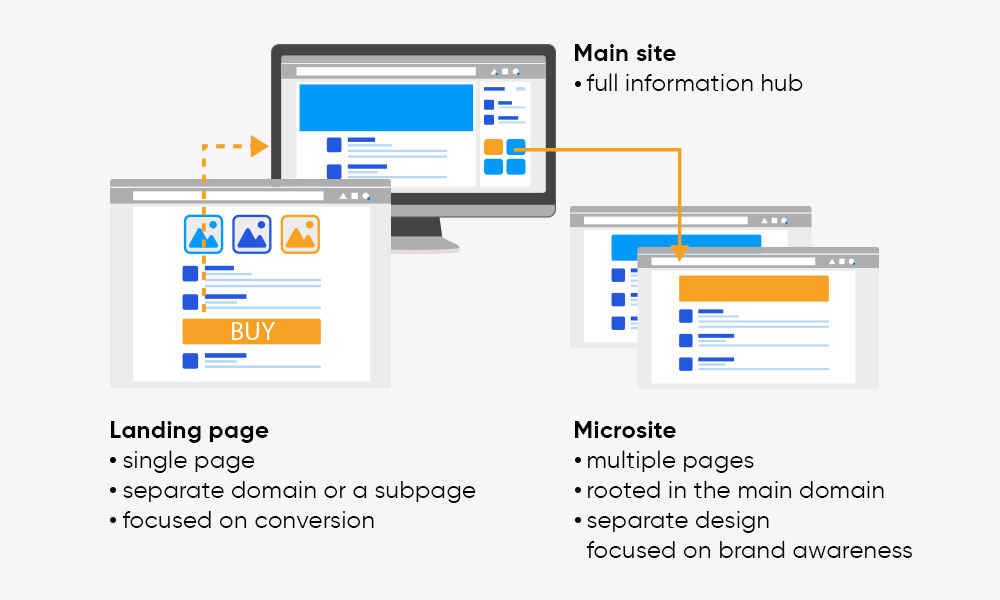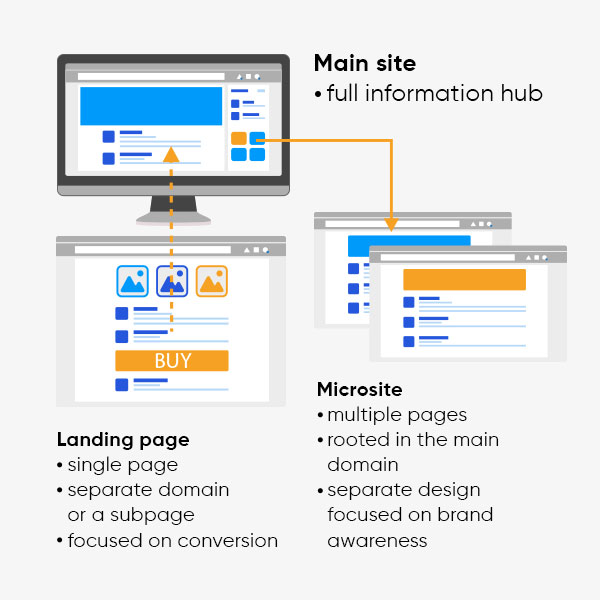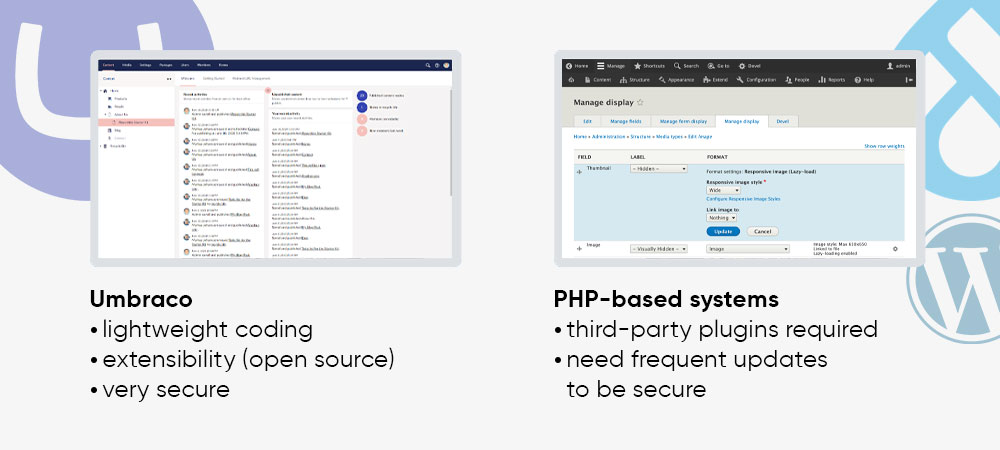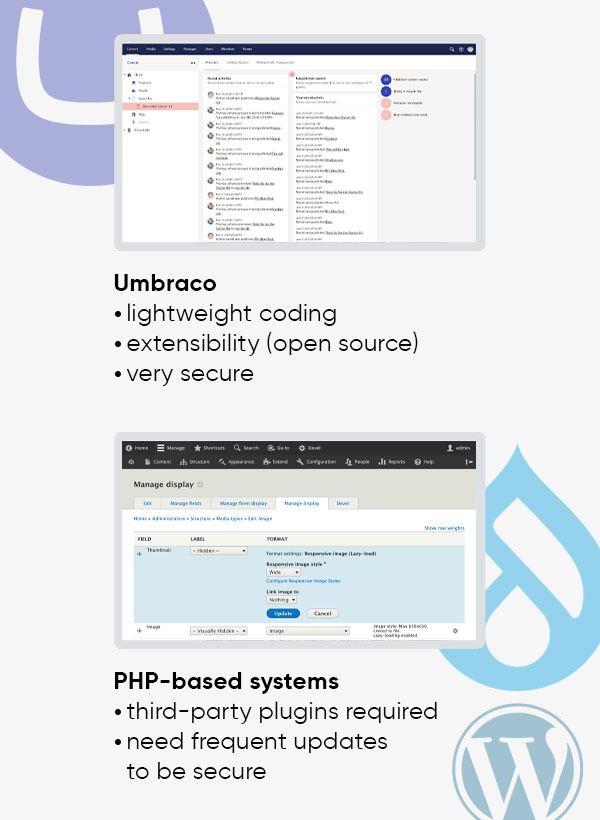Building a microsite or a couple at once is often the first thing new clients approach us about. And often, our first suggestion for a solution is Umbraco. A "microsite" sounds like something small and simple, and Umbraco is a powerful platform for advanced digital solutions. So, based on what you may have read on our site before, this may look like using a pile driver to drive a nail into a wall. However, thanks to its incredible flexibility and lightweight coding, Umbraco is an excellent choice for both microsites and complex websites. Hear us out.
What is a microsite, and how can it help your marketing efforts?
There might be some confusion around the terms "microsite" and "landing page" as they are often used interchangeably. Is this a "potayto, potahto" case? Well, they may not be the strictest terms in a technical sense, but we wouldn't use them synonymously.
A landing page is usually a single page and generally serves a simple purpose - to get people to push that button in the center that says "BUY IT," "DOWNLOAD," "GET THE COUPON," etc. It's usually on its own separate domain, but it can also be just a subpage on your main website. It can be a great tool for time-limited campaigns or event promotions. Microsites, on the other hand, are more like "websites within your website." They are usually rooted in a subdomain of your main site. They also have multiple pages, a separate menu, and different designs but can share elements with the main page.
Purpose-wise, microsites are also different from landing pages since they don't focus on conversions. In marketing terms, microsites are higher in the sales funnel than landers. These are often purely content-based websites that serve to increase brand awareness or promote the brand among new target groups. They are to deliver an immersive experience by providing information for a specific audience quickly and efficiently.
So if, for example, you own a coffee brand called Caffeinator and want to increase the number of consumers by giving away free samples, you can start promoting a landing page called everybodydrinksforfree.com, which allows people to download a coupon for a free sachet of the product. However, suppose you are creating a new sub-brand of decaffeinated coffee and want to attract a new audience. In that case, you could design a microsite called de.caffeinator.com, linked to your primary domain, focusing solely on telling your unique brand's story.
Why choose Umbraco?
Where to even start answering that question? Ok, we were talking about how immersion and easy access to information are big parts of most microsites. Like with any other site, page speed will be an essential factor.
How lightweight coding affects page speed
In the case of many CMSs, especially those PHP-based, like WordPress and Drupal, page loading can be slowed down by a large amount of redundant code, which takes a long time for browsers to process. Umbraco sites, on the other hand, can be coded as highly lightweight.
Now, why is that, and how does Umbraco code differ from platforms like WP or Drupal? The answer lies in the system's architecture, which is designed to minimize the amount of code processing, making it more efficient. Lightweight code generally has less overhead, is more concise, and has fewer dependencies than traditional, heavy-weight code.
For instance, Umbraco is built on the Microsoft .NET framework, and .NET code is compiled into machine code executed directly by the server. In contrast, PHP code is interpreted at runtime, leading to slower performance. It's like comparing an exact recipe written in a cookbook and handwritten notes that the cook has to read aloud to you to be understood. The result may be the same, but the first way will take much less time.
The page loading speed is also affected, for example, by the fact that the .NET framework includes features and tools specifically designed to improve performance, such as just-in-time (JIT) compilation and garbage collection. Additionally, the .NET runtime includes features for efficient memory management, such as automatic reference counting, which helps to minimize memory usage and improve performance.
Ease of use
Unlike CMSs, where every functionality extension requires installing a proper plugin and learning how to use it, Umbraco is a unified system. Admins can copy blocks of content or entire subpages, easily replace media files or build advanced forms and do many other things that would require plugins in the case of many other CMSs.
As an open-source platform, Umbraco also allows for the development of new features. So, extensibility isn't only possible through third-party solutions. The dev responsible for CMS development can always extend the system's core functionality to your needs.
Let's say you'd like your microsite in four different versions referring to the seasons. Summer is coming to an end, and the blue and yellow colors of the layout are changing to brown, and cold brew at the top of the menu must be replaced with pumpkin spice lattes. Umbraco allows us to create all versions of such a microsite in a way that the administrator can freely switch between them.
Manage a couple of sites from one dashboard
While a microsite is a separate entity, it is often intended to share some content elements with your main site or other twin microsites. The Umbraco out-of-the-box API addresses this need. It allows admins to simultaneously manage different digital solutions - like multiple pages or pages and an app - with one management platform.
Never too many security measures
As I mentioned before, Umbraco is built on .NET technology. So it inherits .NET security features that are missing from the PHP-based systems. For instance, .NET is a type-safe language that prevents certain types of security vulnerabilities, such as buffer overflows, by checking data types at runtime.
Also, the .NET framework allows enforcement of security policies at the code level, limiting what a piece of code is allowed to do and helping to prevent malicious code from being executed.
All that, plus regular security updates from Microsoft and regular penetration tests, makes Umbraco extremely safe. And even if your microsite is just a typical branded content site, security measures should never be underestimated. The work put into recovering resources can cost much more than that put into keeping the system safe.
Flexibility, user-friendliness, and security. These are the three most frequently mentioned advantages of Umbraco. We can confirm them from the developer's perspective and the voice of our customers who are satisfied with their systems, whether it's a complex site or a microsite.




